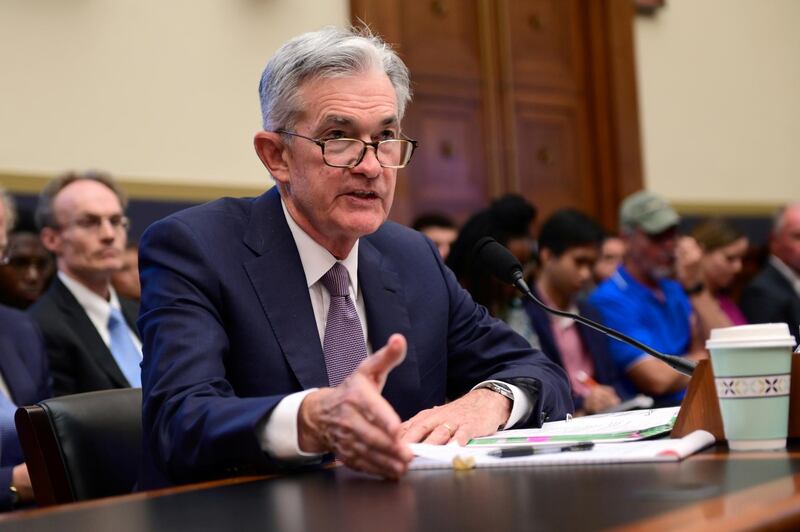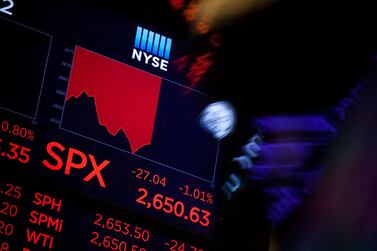The Federal Reserve is preparing to cut interest rates for the first time in a decade because it sees a cooling global economy and no sign of overheating in the jobs market at home.
Since the Fed opened the door to lower borrowing costs last month, plenty more data has arrived to back up the view that “manufacturing, trade and investment are weak all around the world,” chairman Jerome Powell told Congress at a hearing on Wednesday.
He said June’s jobs report, which showed stronger than expected hiring in the US, was “great news” - but not enough to tilt the balance, because wages aren’t rising fast enough to trigger much inflation. In fact, Mr Powell made it clear that inflation is still too low, according to Bloomberg.
Markets saw his comments as confirmation that rates are headed lower at the Fed’s next meeting on July 30-31. Traders stepped up bets that the reduction will be by half a percentage point, though the consensus still foresees a quarter-point cut. Mr Powell didn’t respond directly when asked about the possibility of a 50 basis-point cut.
He also fielded questions about the threat to his job from President Donald Trump.
Mr Trump has attacked the Fed for keeping rates too high, breaking with the recent convention of presidents not intervening in monetary policy. He has also explored ways he could replace Powell.
With several policymakers voicing support for Fed independence, Mr Powell was asked how he’d respond if Mr Trump tried to fire him.
“My answer would be no,” Mr Powell said. “The law clearly gives me a four year term and I intend to serve it."
Trade tensions are weighing on business investment and there are other reasons to worry about the global economy, he said.
“Momentum appears to have slowed in some major foreign economies,” Mr Powell said, and the weakness could spread to impact a US economy that’s currently on a “solid footing”.
The dollar fell to a five-day low on Thursday following Mr Powell's comments, though investors were wary of selling dollars aggressively until a policy review later this month, Reuters reported.
His comments about "broad" global weakness that was clouding the US economic outlook amid uncertainty over the fallout from the trade conflict with China and other nations did little to change market expectations - money markets expect one rate cut later this month and a cumulative 68 basis points of cuts until the end of 2019 - but market watchers said Mr Powell's views will drive the dollar.
"Once we get a quarter-point rate cut, which markets are widely expecting, Mr Powell will keep all options open on the table, and that means the dollar's outlook is uncertain", said Manuel Oliveri, an FX strategist at Credit Agricole in London.
Against a basket of other currencies, the dollar fell 0.2 per cent to 96.83, its lowest since July 5 and near the three-month low of 95.84 from late June.
Uncertainty about the dollar's outlook prompted some investors to unwind short positions against some heavily shorted currencies, such as the Australian dollar, which rose 0.2 per cent in early London trading.
Latest positioning data showed that hedge funds had built up a large short position in the Australian dollar in recent weeks because of the trade tensions between Washington and Beijing.
In contrast, hedge funds had rapidly unwound large long positions in the dollar, especially against a basket of major and emerging-market currencies, anticipating U.S. rate cuts.
Elsewhere, the British pound rose from six-month lows to $1.2529. But it remains down for the week, amid Britain's economic gloom and a fast-approaching Brexit deadline.
Gold prices scaled a more than one-week peak on Thursday. Spot gold was up 0.3per cent at $1,422.40 per ounce as of 07.11 GMT, after earlier hitting its highest since July 3 at $1,426.
US gold futures jumped 0.9 per cent to $1,424.80 an ounce.
"Last night's move from the Fed is pretty convincing that they are going towards more of a risk management overview policy which is dovish," said Stephen Innes, managing partner at Vanguard Markets, adding "also dollar trading lower is a huge support for gold"
"The Fed not only focused on concerns within the US economy, but also took into consideration the global economy, negative impact from trade wars and basically hitting all the right buttons for gold bulls."







